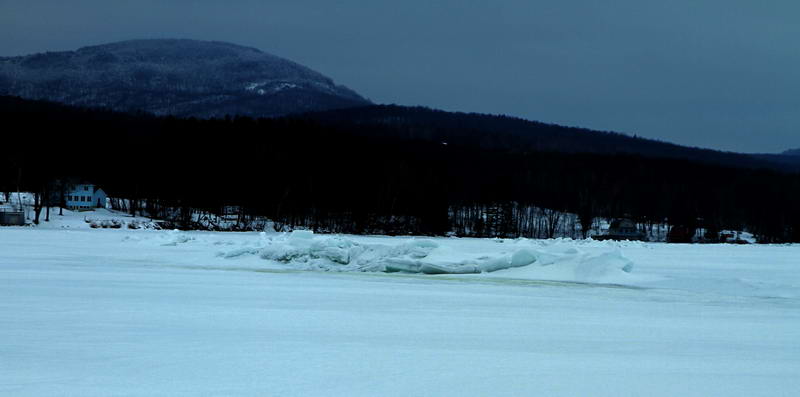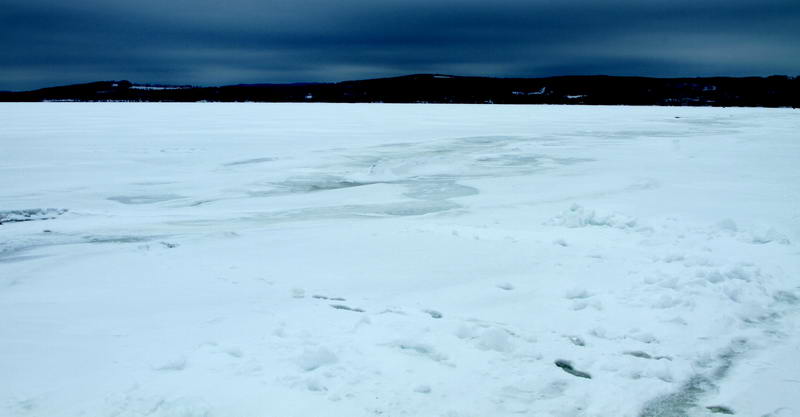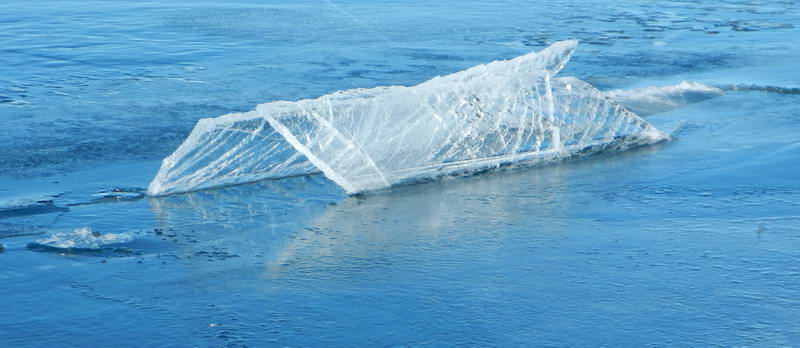Tragedy on Lake Memphremagog
Jacques LeBlanc died on Saturday March 2, 2013 while moving fishing shanties off Lake Memphremagog with a tractor as he has done for many years. He leaves behind an extended family and many friends. Click here for an article and video on the tragedy by TV station WCAX.
The following focuses on the ice and vehicle factors in the accident in an effort to help others avoid a similar situation in the future. This report is not intended to be critical of Mr LeBlanc. As his son put it in the WCAX interview, he made a mistake. We all make potentially life threatening mistakes from time to time and the only difference for most of us is that we were luckier than Mr LeBlanc was on March second.
As shown on this map, there was a pressure ridge that angled out into the lake. The first half mile of the ridge was a classic overlapped ridge with ice pieces sticking up from 1 to 3 feet along its length, making is easy to see. For the last few hundred yards the ridge changed to a folded ridge before ending.
 The overlapped section of the ridge as it zig-zags toward shore. The ice piles are up to 3 feet high making the ridge easy to see. Note: all the snow pictures have the contrast turned way up to make the snow features visible.
The overlapped section of the ridge as it zig-zags toward shore. The ice piles are up to 3 feet high making the ridge easy to see. Note: all the snow pictures have the contrast turned way up to make the snow features visible.
 This this is the snow covered, folded ridge, south east of the accident. The main part of the ridge comes into the picture on the middle of the left side. The slush in the footprints is related to submersion of broken pieces of the ice sheet along the side of the ridge. The ridge itself is covered with frozen slush, wet slush and snow.
This this is the snow covered, folded ridge, south east of the accident. The main part of the ridge comes into the picture on the middle of the left side. The slush in the footprints is related to submersion of broken pieces of the ice sheet along the side of the ridge. The ridge itself is covered with frozen slush, wet slush and snow.
 An example of tented ice in better light. This is half inch thick ice over night in a puddle on a ridge. When the ice sheet expands as it warms, the thin ice buckles into a 'tent'.
An example of tented ice in better light. This is half inch thick ice over night in a puddle on a ridge. When the ice sheet expands as it warms, the thin ice buckles into a 'tent'.
The folded section was visible from the a semi-continuous line of tented ice roughly a foot high and large areas of frozen slush where blowing snow had caught in the open pools of the ridge. The accident occurred about half way along the length of the folded section. It is common for an overlapped ridge that terminates in the middle of an ice sheet to have a section of folded ridge at the end. Folded ridges are generally harder to see because they do not stick up much. When they get covered with slush and some dry snow like this one was they are even harder to spot. Low light makes the situation even worse.
The shanty can be seen in the upper left. The tracks were most likely made by the tractor or an ATV.
 This is what the folded ridge looked like at its south-east end.
This is what the folded ridge looked like at its south-east end.
There were about three possible tractor tracks that went around the end of the ridge about 80 feet away from it. This suggests that Jacques was aware of the presence of the folded section of the ridge and was avoiding it. It was thought that his last trip in was near or after dark and that he lost his path to the end of the ridge and wound up crossing it. I crossed or attempted to cross the folded section in several places and and found many weak spots with my test pole (ice less than 4" thick).
Some background:
- Jacques was universally reported to have had many years of experience on the ice in front of his farm and B&B.
- The weather the day of the accident was overcast and it had been snowing lightly for several days. Wind in nearby Newport on Saturday (3/2/2013) averaged 7 mph with a maximum of 20. Temperatures were mostly below freezing. When I visited the ice, the weather was similar and the light was flat making it hard to spot details on the ice. Blowing snow made it worse.
- The ice in the area was 20" thick and comprised of about 2" of snow ice over 18" of black ice. A 17" dry hole did not weep visible water into the bottom of the hole over about 10 minutes indicating that the ice was not thawed significantly. In theory, a 20" thick, unthawed ice sheet of ice should be able to support about 20 tons safety factor of about 1.5. The 55 hp tractor probably weighed 2-1/2 to 3 tons.
- There was a windblown snow layer that covered all the ice and ranged from an inch to several inches thick. There was slush under some of the snow. The snow had formed significant drifts at obstructions like overlapped ridges and smaller drifts around the tented ice in the folded ridge.
Lessons:
- With the benefit of hindsight, a tractor is great for pulling shanties but is a poor vehicle to break through with. It sinks quickly, allowing minimal time to get out of the cab and off the vehicle before it sinks. The same thing applies to even heavier vehicles like plow trucks, snowmobile trail groomers and Zambonies.
- There have been some accidents where fishermen fell through and pulled their fishing sleds into the hole, on top of them. The same can be said for pulling a shanty. A rope significantly longer than the water depth would be better. A 'V' bridal or something similar will probably be necessary to get the shanty to follow the tow vehicle on a long tether.
- These two factors make using tractor on the ice a low margin for error endeavor. Removing the cab and using a longer tether might have improved the survival odds. A better approach, if heavy vehicles are going to be used, would be more scouting, drilling/testing and marking of routes and hazards. On a big, thick ice sheet that can seem like too much bother, until a brakthrough occurs when it suddenly will be a very good idea.
- Folded ridges, can be treacherous, especially for vehicles. They are often hard to spot, especially if there is blowing snow to fill any exposed water with slush and make drifts over anything that does stick up. Folded ridges can be expected at where ever an overlapped ridge terminates. Sometimes they occur in isolation. Some ridges are a mix of overlapped and folded types so a gap in piled up ice in an overlapped ridge is likely to a folded section and just as weak as the rest of the ridge.
Bob Dill
PS: Investigating and reporting on an accident like this requires making some assumptions. If I overlooked important details or have made wrong assumptions, please get in touch.
